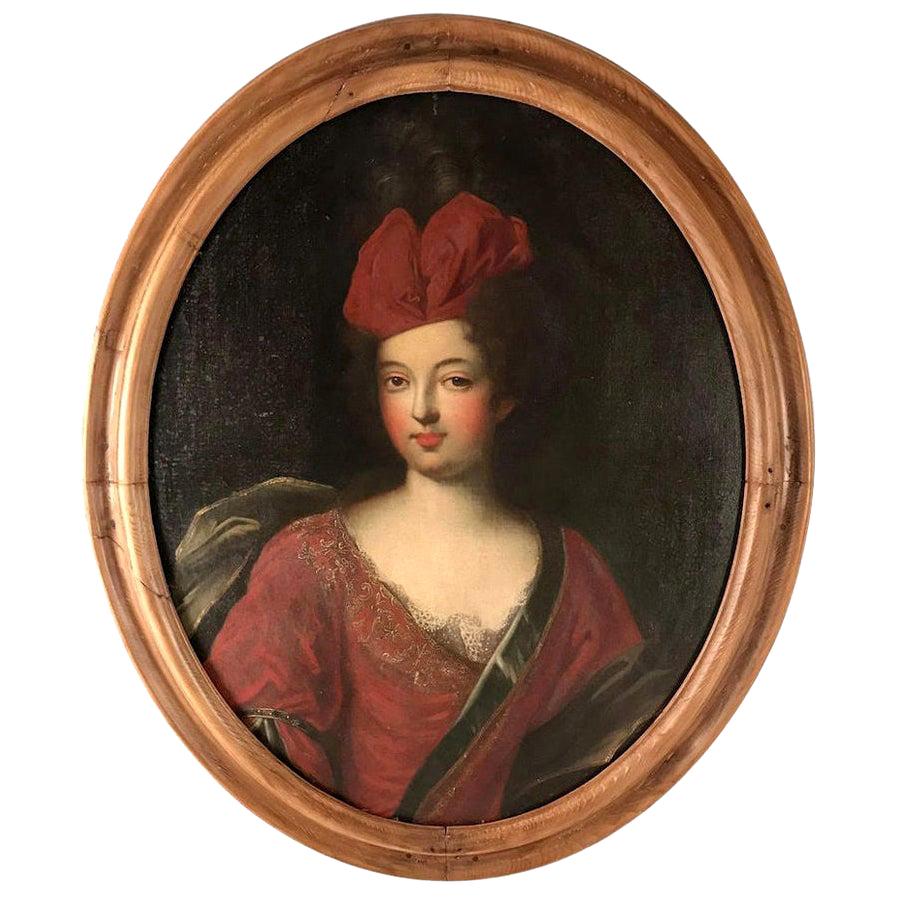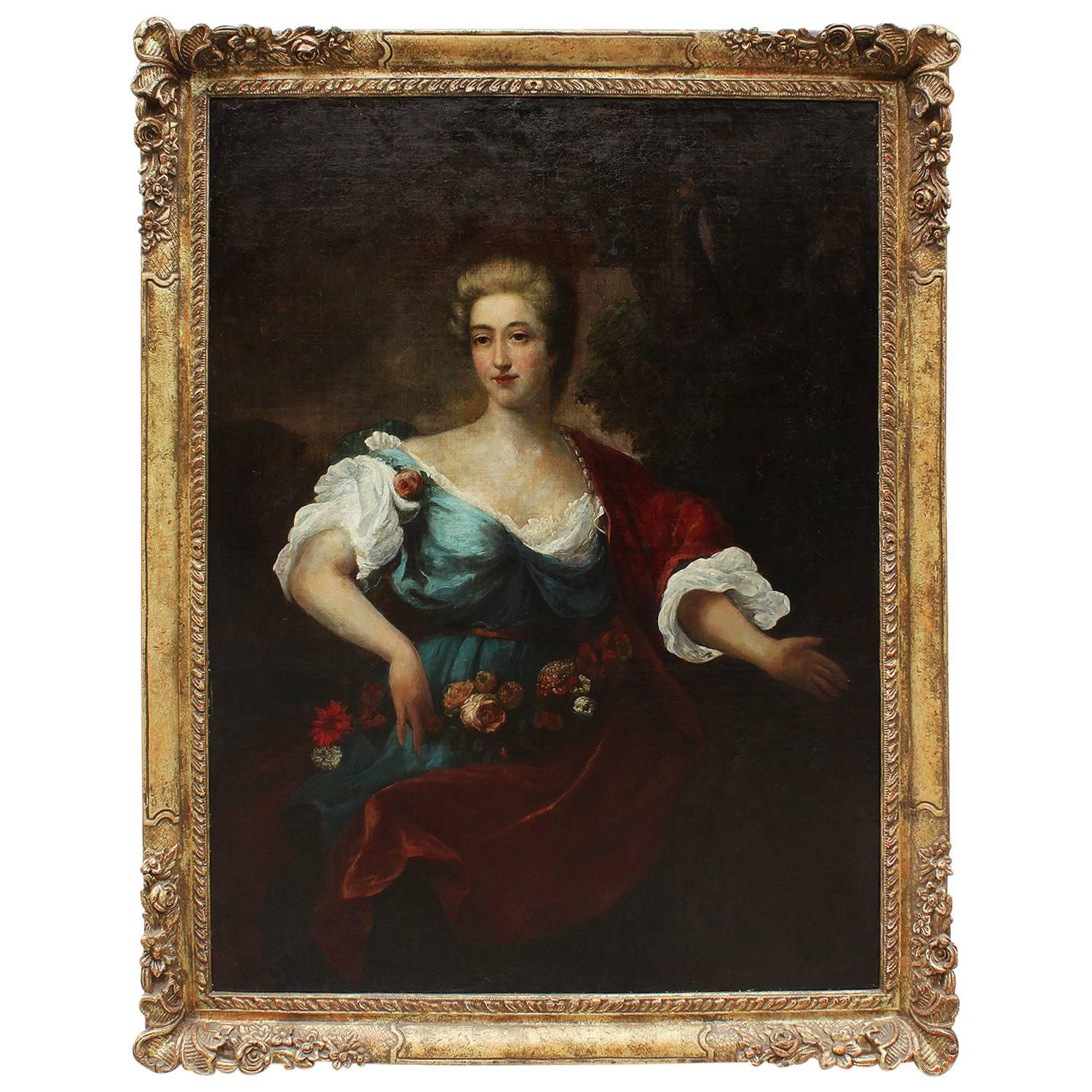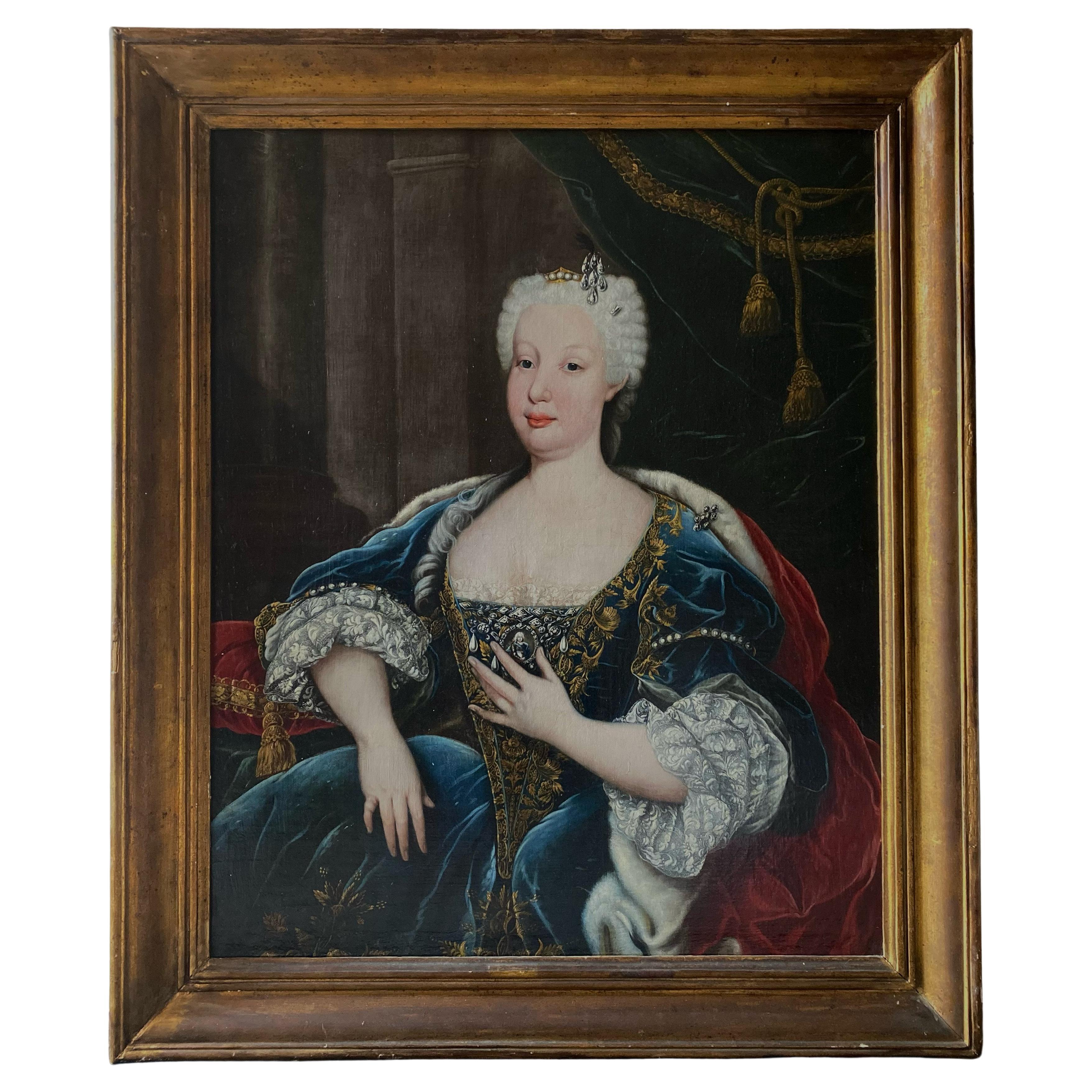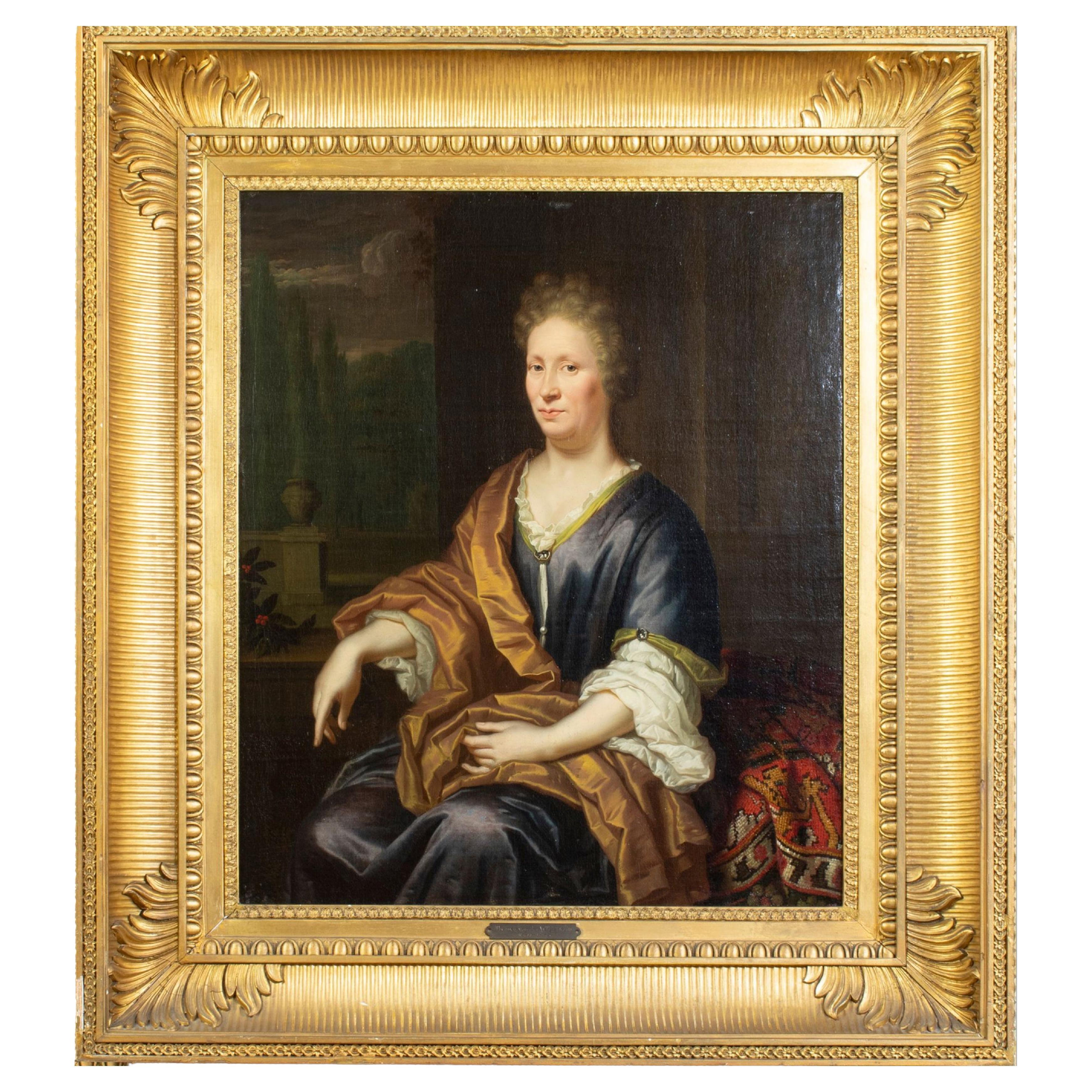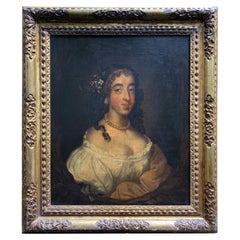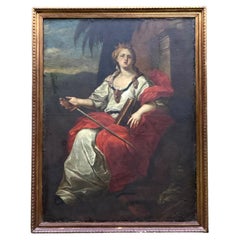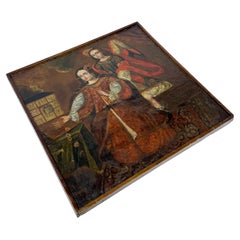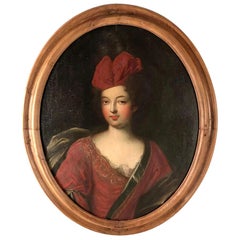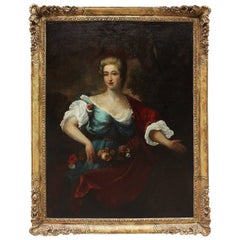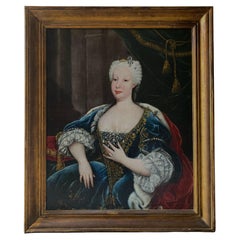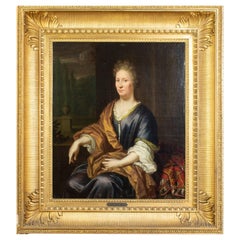Items Similar to Circle of Nicolas de Largillière 1656 -1746 Portrait of a Noble Lady
Want more images or videos?
Request additional images or videos from the seller
1 of 10
Circle of Nicolas de Largillière 1656 -1746 Portrait of a Noble Lady
$12,000
£9,070.51
€10,423.63
CA$16,709.93
A$18,589.11
CHF 9,744.64
MX$227,154.36
NOK 124,085.88
SEK 116,809.69
DKK 77,808.46
Shipping
Retrieving quote...The 1stDibs Promise:
Authenticity Guarantee,
Money-Back Guarantee,
24-Hour Cancellation
About the Item
This striking oval portrait, attributed to the circle of Nicolas de Largillière, exemplifies the refined elegance and artistic sophistication of late 17th to early 18th-century French portraiture. The sitter, a noblewoman, is portrayed with exceptional attention to detail, wearing a resplendent golden gown richly embroidered and paired with an elaborate crimson drapery that cascades gracefully around her shoulders. Her powdered hair, adorned with delicate blue ribbons, and the fine lace details of her bodice emphasize her aristocratic status and refined taste.
The painting reflects the influence of Nicolas de Largillière, renowned for his ability to blend lifelike representation with the grandeur expected of aristocratic portraits. The sitter’s serene yet confident expression, soft rendering of facial features, and glowing palette are hallmarks of his style and his artistic circle.
This piece is set within an ornately carved giltwood frame, featuring intricate Rococo floral motifs. While the frame adds significant decorative appeal, it requires restoration to repair areas of wear and damage, which, once addressed, will further enhance the overall presentation.
This portrait represents a fine example of Baroque artistry and serves as a testament to the exceptional craftsmanship of the period. An ideal addition for collectors or admirers of historic French art, this piece would bring elegance and historical depth to any collection or interior.
- Attributed to:(circle of) Nicolas de Largillierre (Artist)
- Dimensions:Height: 40.95 in (104 cm)Width: 35.44 in (90 cm)Depth: 5.52 in (14 cm)
- Style:Baroque (Of the Period)
- Materials and Techniques:
- Place of Origin:
- Period:Late 17th Century
- Date of Manufacture:17th -18th Century
- Condition:Wear consistent with age and use. The frame needs to be restored.
- Seller Location:Rio De Janeiro, BR
- Reference Number:1stDibs: LU9400242671552
About the Seller
5.0
Vetted Professional Seller
Every seller passes strict standards for authenticity and reliability
Established in 2000
1stDibs seller since 2023
6 sales on 1stDibs
Typical response time: 12 hours
- ShippingRetrieving quote...Shipping from: Rio De Janeiro, Brazil
- Return Policy
Authenticity Guarantee
In the unlikely event there’s an issue with an item’s authenticity, contact us within 1 year for a full refund. DetailsMoney-Back Guarantee
If your item is not as described, is damaged in transit, or does not arrive, contact us within 7 days for a full refund. Details24-Hour Cancellation
You have a 24-hour grace period in which to reconsider your purchase, with no questions asked.Vetted Professional Sellers
Our world-class sellers must adhere to strict standards for service and quality, maintaining the integrity of our listings.Price-Match Guarantee
If you find that a seller listed the same item for a lower price elsewhere, we’ll match it.Trusted Global Delivery
Our best-in-class carrier network provides specialized shipping options worldwide, including custom delivery.More From This Seller
View AllSir Peter Lely - Portrait of Lady with baroque pearl earring - 17th Century Oil
By Sir Peter Lely
Located in Rio De Janeiro, BR
17th-Century English Portrait, Attributed to Sir Peter Lely
A striking 17th-century English oil on canvas portrait, attributed to the renowned court painter Sir Peter Lely (1618–1680...
Category
Antique 17th Century British Baroque Paintings
Materials
Canvas
Saint Catherine of Alexandria, European School, Circa Late 17th to Early 18th Ct
Located in Rio De Janeiro, BR
Monumental Baroque Oil on Canvas – Saint Catherine of Alexandria, European School, Circa Late 17th to Early 18th Century – As Found
Impressive in scale and rich in allegorical power...
Category
Antique 17th Century Italian Baroque Paintings
Materials
Canvas
Rare 18th-Century Spanish Colonial Painting – Nun in Memento Mori Iconography
Located in Rio De Janeiro, BR
Rare 18th-Century Spanish Colonial Painting – Nun in Memento Mori Iconography
An exceptional 18th-century Spanish Colonial oil painting on canvas, depicting a veiled nun in a strikin...
Category
Antique Mid-18th Century Peruvian Spanish Colonial Paintings
Materials
Canvas
Saint Mary Magdalene - Spanish Colonial - 18th Century
Located in Rio De Janeiro, BR
An exquisite Spanish Colonial oil painting from the 18th century, depicting Saint Mary Magdalene in a richly detailed composition. This piece showcases the characteristic Cuzco Schoo...
Category
Antique Mid-18th Century Bolivian Spanish Colonial Paintings
Materials
Canvas
Magnificent 18th Century Venetian Madonna
Located in Rio De Janeiro, BR
Great oil on canvas depicting Madonna and Child. Carved, gilded and polychrome wooden frame with floral arrangements. Venetian, 18th Century.
Dimensions in centimeters: CANVAS 69cm H x 51cm / FRAME 107cm H x 80cm.
In art, a Madonna is a representation of Mary, either alone or with her child Jesus. These images are central icons for both the Catholic and Orthodox churches. The word is from Italian ma donna 'my lady' (archaic). The Madonna and Child type is very prevalent in Christian iconography, divided into many traditional subtypes especially in Eastern Orthodox iconography, often known after the location of a notable icon of the type, such as the Theotokos of Vladimir...
Category
Antique Mid-18th Century Italian Baroque Paintings
Materials
Canvas
Mary Queen of Heaven - Early 17th Century Spanish Colonial oil on canvas
Located in Rio De Janeiro, BR
This exquisite early 18th-century Spanish Colonial oil painting, originating from Bolivia, portrays “Mary, Queen of Heaven.” With meticulous craftsmanship, it illustrates the Coronat...
Category
Antique Early 18th Century Bolivian Spanish Colonial Paintings
Materials
Canvas
You May Also Like
Late 17th Century Oil Portrait of a Lady
Located in Lymington, GB
An oil on canvas portrait of a young French courtier, circa 1690.
This evocative antique French-school picture has been attributed to the portrait painter Jean-François de Troy (1679-1752).
De Troy was famous as a portrait painter of fashionable society women.
This is a very attractive late-17th century painting surviving in its original frame and stretcher. The canvas appears to be untouched.
References:
'Jean François de Troy, The Alarm, or the Gouvernante Fidèle', at the Victoria and Albert Museum, London.
'Jean François de Troy, Paris 1679 - Rome 1752', at the Thyssen-Bornemisza Museum.
Laurie G. Winters, Troy, de, Grove Art Online, Oxford Art Online, Oxford University Press, 6 May 2016.
Everett Fahy & Jayne Wrightsman...
Category
Antique 17th Century French Paintings
Materials
Canvas
French 18th-19th Century Oil on Canvas Portrait of Lady, after Jean-Marc Nattier
By Jean-Marc Nattier
Located in Los Angeles, CA
A very fine French 18th-19th century oil on canvas portrait of a posing lady with flowers, after Jean-Marc Nattier (1685-1766) within an ornate gilt wood carved frame, circa 1800.
...
Category
Antique Early 19th Century French Louis XV Paintings
Materials
Canvas, Giltwood
$11,960 Sale Price
20% Off
Portrait of D. Maria Bárbara De Bragança, Circle of Louis-Michel Van Loo
By H. van Loon
Located in Lisboa, PT
PORTRAIT OF D. MARIA BÁRBARA DE BRAGANÇA (1711-1758), QUEEN OF SPAIN
Circle of Louis-Michel van Loo (1707-1771)
Oil on canvas
Her Royal Highness, the Infanta Maria Barbara of Braganza (1711-1758) was the first-born child of King John V of Portugal (1689-1750) and his queen consort Maria Anna of Austria (1683-1754). Born in December 1711, she had the Convent Palace of Mafra built in her honour following a vow made by her royal father. Her status as Princess of Brazil, inherent to 18th century Portuguese presumptive heirs, would however be superseded once the queen gave birth to two male princes, D. Pedro (1712-1714) and D. José (1714-1777), preventing her from ascending to the throne.
Daughter of one of the most illustrious monarchs of his time, Maria Barbara was carefully educated to become a fond admirer of the arts, and of music in particular, having had the Italian composer Domenico Scarlatti (1685-1757) as her music teacher.
On the 10th January 1723 the young princess was betrothed to the Infante Ferdinand of Spain (1713-1759), eldest son of King Philip V (1683-1746). Six years later, on the 19th January, she entered her new country in a carefully choreographed ceremony that became known to history as the “Exchange of the Princesses”. This unique event took place on a specially built Bridge-Palace, a wooden, luxuriously decorated structure that included various modules and rooms, on both banks of the river Caia, the natural border between the town of Elvas in Portugal and of Badajoz in Spain. Simultaneously, on the same day that the Portuguese Infanta crossed the border to marry the Spanish Crown Prince, her new sister in law, the Infanta Mariana Victoria of Bourbon (1718-1781), her husband’s sister, crossed the same bridge in the opposite direction to marry Prince D. José, the Portuguese heir to the throne.
Once married, Maria Barbara would spend 17 years as Princess of Asturias, only becoming Queen of Spain at her husband’s accession following the death of Philip V in 1746. She is portrayed in the 1743 painting by Louis-Michel van Loo (1707-1771) now in the Prado Museum, in which Philip V had himself represented with all his close family.
The new Queen would take an important role at court eventually becoming the liaison between her husband and the King of Portugal, particularly throughout the negotiations for the Treaty of Madrid (1746-1750). Maintaining her interest in music, she patronized the Italian castrato singer Farinelli (1705-1782) while remaining close to her old master Scarlatti, having herself composed some sonatas for a large orchestra. She would also commission and fund the building of the Royal Salesians Monastery complex in central Madrid, where both her and Ferdinand VI are buried.
The portrait we are presenting for sale shows the Queen in half-length, turning left at three quarters. She is wearing a blue low-cut dress embroidered with flowers and foliage, over a lace cuffed white blouse, and an ermine cloak pined on the left-hand side by a diamond broach. The powdered hair style is held sideways by a seven diamond and black plume headdress and topped by a small gold and pearl crown. The right arm rests on a cushion while the left hand, at chest height, holds a miniature male portrait.
The Infanta’s features are analogous to the 1725 portrait by the painter Domenico Duprà (1689-1770), also in the Prado Museum collection. Further similarities can be found in another portrait by Louis-Michel van Loo, in which a seven diamond and black plume headdress is also present. In this work, the cushion supporting Maria Barbara’s right arm has also some obvious similarities to our painting. The same diamond headdress reappears in Van Loo’s above-mentioned portrait of Philip V’s family dated from 1743.
It is nevertheless in Lisbon’s Ajuda National Palace that it is possible to find an almost identical depiction of the Infanta holding a miniature portrait of her husband. In it, the future Ferdinand VI is portrayed facing right at three quarters and wearing a curly wig, suit of armour, the golden fleece insignia and a blue band, in a composition that closely resembles an 18th century Spanish school painting that appeared in the art market in January 2016.
Another detail common to various portraits of the Portuguese Infanta and Queen of Spain is the small gold and pearl crown on her head. In another Van Loo painting, also from the Prado Museum, in which Maria Barbara is portrayed as Queen, this crown is represented together with a headdress similar to the one previously described. Another two paintings by the same artist, at the Royal Academy of Saint Ferdinand, include the same ornament.
We must also refer the paintings by the artist Jean Ranc (1674-1735). In one, dating from 1729 (Prado Museum), the Infanta is depicted outdoors holding a flower bouquet and wearing a yellow silk dress with red cloak, and a set of diamond and ruby jewellery that includes a headdress similar to the one present in our portrait. Another work by the same artist, belonging to the Complutence University of Madrid, depicts the Infanta sumptuously dressed in identical colours to our painting and wearing an elaborate headdress and diadem.
These portraits, beyond their iconographical importance as contemporary records of the Infanta and Queen Maria Barbara, are also illustrative of 18th century fashion for jewelled head dressing. Often, flowers were combined with joyful adornments, composing almost theatrical displays that would reinforce the ostentatious nature of the image. The ornamental flowers and the chromatic character of the jewels would complement the luxury of the colourful dresses in blue, crimson, green or other silk shades, in compositions whose sole purpose was to highlight a royal sitter’s wealth and power, becoming an essential statement accessory within the strict court protocols and codes of conduct.
Circle of Louis-Michel van Loo (1707-1771)
Slowly but steadily, the resolute, tranquil and dignified attitude of Renaissance and Baroque portraiture becomes artificial and presumptuous. Mid 18th century society favours elusive expression and psychological deepness, albeit limited to the face, that, with emphasis on detail, on the rich colour palette and on changing costumes and landscapes, associated to the courtliness of gestures, creates a strongly artificial environment while maintaining a highly poetic intrinsic character.
Louis-Michel van Loo followed a dynasty of famous Dutch origin artists that had settled in France. Initially taught by his father, Jean-Baptiste von Loo (1684-1745), the younger van Loo studied in Turin and Rome and frequented the Paris Academy. In Rome he worked with his uncle Charles-André van Loo (1705-1765) and become a painter for the Turin Court. In 1737 he arrived in Spain being summoned by Philip V to succeed Jean Ranc as painter of the king’s chamber.
In Madrid, his work covers the numerous Court commissions and the Royal Saint Ferdinand Fine Arts Academy, of which he was a founding member and director for the Painting department in 1752. Is production at court consisted essentially of numerous portrait paintings, often Royal gifts...
Category
Antique 18th Century Spanish Baroque Paintings
Materials
Canvas
Thomas VAN DER WILT (1659-1733) "Portrait of Noble Woman"
By Europa
Located in Madrid, ES
Thomas VAN DER WILT (1659-1733) "Portrait of Noble Woman",
oil on canvas
55cm x 46cm without frame
65cm x 56cm with frame
very good conditions
Thomas van der Wilt (1659–1733) was an...
Category
Antique Early 18th Century Dutch Baroque Paintings
Materials
Paint
18th century Portrait of Lady Oil on Canvas in Giltwood Frame
Located in Savannah, GA
English oil on canvas portrait dating from the late 1700s painted in the manor of Joshua Reynolds. We believe the giltwood frame could be the original as it is right for the period. ...
Category
Antique 1790s English Rococo Paintings
Materials
Canvas, Wood
$3,900 Sale Price
40% Off
Nicolas de Largillière - Portrait of a Lady, Paris, circa 1695
By Nicolas de Largillière
Located in PARIS, FR
Nicolas de Largillière (Paris, 1656-1746)
Portrait of a lady, circa 1695
Oil on canvas (relined): 76 x 61 cm
Framed: h. 97 cm, l. 82 cm
To be included in the forthcoming catalogue raisonné of the artist by Dominique Brême, director of museum of Sceaux and artist specialist.
Our work presents a majestic French aristocrat against the backdrop of a twilight landscape.
The face seen from the front, the body turned three-quarters, the young woman is portrayed half-length, revealing her slim belted waist.
The elongated face with rosy cheeks, almond-shaped eyes, straight nose and strong chin, solemn expression, the young woman sketches...
Category
1690s Old Masters Figurative Paintings
Materials
Canvas, Oil
More Ways To Browse
Antique Lace Ribbon
Oval Rococo Portrait
Vintage Bauhaus Jewelry
Vintage Jewellery Display Cabinets
White Tara
William And Mary Chest Of Drawers
Wwi German
Zenith 1960
16th Century Tudor
17th Century Italian Commode
17th Century Japanese Screens
1930 Kitchen Chairs
1960s Bedroom Suite
70s Bed
A Louis Xv Bombe Marquetry Commode
Antique 18th C Walnut Chest Of Drawers
Antique Beds India
Antique Delft Bowl
